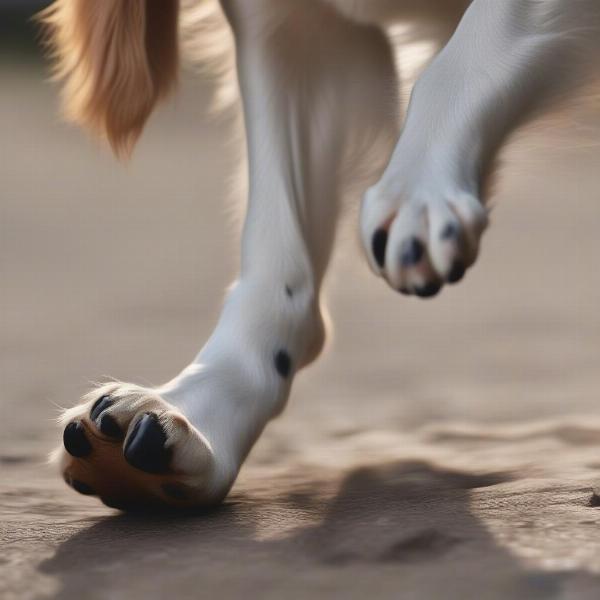A dog’s leg injury can be a stressful experience for both the pet and the owner. Recognizing the signs of a broken leg is crucial for prompt treatment and a better recovery. If you suspect your dog has a fractured leg, this article will guide you through the common symptoms, what to do, and how to care for your furry friend during this difficult time.
Recognizing the Signs of a Broken Leg in Dogs
Several indicators can suggest your dog might have a broken leg. While some signs are obvious, others can be subtle. Being aware of these signs will help you take appropriate action.
- Limping or inability to bear weight: This is often the most obvious sign. If your dog suddenly refuses to put weight on a leg, it’s a strong indication of a serious problem.
- Swelling and bruising: The affected area may appear swollen and bruised. You might also notice heat radiating from the injured leg.
- Pain and yelping: Your dog might yelp or cry out in pain when the injured leg is touched or moved. They may also exhibit signs of general discomfort, like restlessness or whimpering.
- Deformity or unnatural angle: A clear break might result in a visible deformity, with the leg bent at an unusual angle.
- Grinding or clicking sound: Sometimes, you might hear a grinding or clicking sound when the broken bones rub against each other.
 Dog Limping with a Potentially Broken Leg
Dog Limping with a Potentially Broken Leg
What to Do If You Suspect a Broken Leg
If you notice any of the signs mentioned above, it’s crucial to act quickly and calmly. Your dog’s well-being depends on your prompt response.
- Restrict movement: The first step is to prevent further injury. Confine your dog to a small, safe space and discourage any movement.
- Muzzle your dog (if necessary): Even the gentlest dog can bite out of pain and fear. If your dog seems agitated or in significant pain, consider muzzling them before handling them.
- Transport your dog carefully: If possible, gently lift your dog onto a flat surface like a board or blanket to transport them to the vet. Support the injured leg to minimize movement.
- Seek immediate veterinary attention: A broken leg requires professional medical attention. Contact your veterinarian immediately and explain the situation. They will advise you on the best course of action.
Caring for Your Dog After a Broken Leg
After the initial diagnosis and treatment, your dog will require special care during the healing process.
- Follow your veterinarian’s instructions: Adhere strictly to the prescribed medications, rest, and activity restrictions.
- Provide a comfortable and safe space: Ensure your dog has a quiet, comfortable space where they can rest undisturbed. Limit access to stairs and slippery surfaces.
- Pain management: Administer pain medication as prescribed by your vet to keep your dog comfortable.
- chain dog tag Monitor the healing process: Regular check-ups with the vet are essential to monitor the healing progress and address any complications.
How Can I Prevent My Dog from Breaking a Leg?
While accidents happen, some precautions can reduce the risk of leg fractures in dogs.
- Maintain a healthy weight: Obesity puts extra strain on joints and bones, increasing the risk of fractures.
- Supervise outdoor activities: Ensure your dog is supervised during playtime and walks, especially in areas with potential hazards.
- dog pastern Provide a safe home environment: Remove any potential tripping hazards or obstacles in your home.
- Supplement with joint support: Consider joint supplements for senior dogs or those prone to joint problems.
Conclusion
Recognizing the signs of a broken leg in your dog is vital for timely intervention. By acting quickly, following your veterinarian’s instructions, and providing proper care, you can help your dog recover fully and regain their mobility. Remember, immediate veterinary attention is crucial for a positive outcome.
FAQ
- How long does it take for a dog’s broken leg to heal? Healing time varies depending on the severity of the fracture, but it typically takes several weeks to several months.
- What are the treatment options for a broken leg in dogs? Treatment options include splinting, casting, surgery, or a combination of these.
- Will my dog be in pain after surgery? Your vet will prescribe pain medication to manage your dog’s discomfort during recovery.
- Can a dog walk on a broken leg? No, a dog should not be allowed to walk on a broken leg.
- How much does it cost to treat a broken leg in a dog? The cost varies based on the severity of the fracture and the chosen treatment method.
- Are certain breeds more prone to leg fractures? Small breeds and those with certain genetic predispositions can be more susceptible to leg fractures.
- What are the signs of infection in a dog’s broken leg? Signs of infection include increased swelling, redness, pus, and a foul odor.
Related Articles
ILM Dog is your trusted resource for all things canine. We offer expert advice on dog breeds, health, training, nutrition, grooming, and much more. Whether you’re a new dog owner or a seasoned expert, ILM Dog provides valuable insights and practical tips to help you care for your furry companion. Contact us at [email protected] or +44 20-3965-8624 for personalized advice. Visit us at ILM Dog for more information.